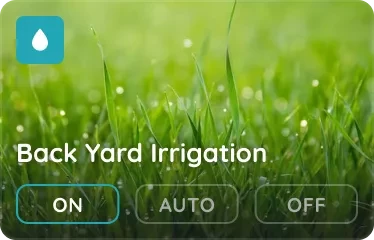On this page
Valves in the PIERRE smart home system are essential for controlling water flow in various applications, such as floor heating, wall cooling, and managing the main water supply. These valves can be connected to the system using relay boards, either the 4-channel or 8-channel SSR board, depending on the number of valves. Once integrated into the PIERRE system, they can be managed easily through the app, allowing full control over water flow and home automation scenarios.
PID-regulated valves provide precise control over water flow by adjusting the valve position based on feedback from sensors. This makes them ideal for applications where constant monitoring and fine-tuning are necessary, such as in complex heating systems or sensitive water management setups. The PIERRE system can automatically adjust the PID-regulated valve to maintain optimal conditions, increasing efficiency and minimizing manual intervention.
Water valves are used for general water management, including controlling the main water supply. These valves can be connected to flood sensors or other devices to automate the opening or closing of water lines in response to specific conditions, such as a leak or a scheduled irrigation cycle. Integration into the PIERRE smart home system ensures that water usage is controlled efficiently, reducing waste and enhancing home safety.
Electric valves (230V) are designed for large-scale water control tasks and are powered by the main electrical system. They are robust and reliable, making them ideal for managing heavy-duty applications such as water supply for larger homes or commercial systems. Once connected to the PIERRE smart home system, electric valves can be automated to respond to various scenarios, such as turning off the water supply during rain or when water is not needed.
When controlling electric valves with Solid State Relays, NC (normally closed) valves are used to ensure safety. These valves remain closed when no signal is present, meaning that in case of system failure or power outage, the water supply will be automatically cut off, preventing flooding or other potential hazards. The PIERRE smart home system ensures that these valves function optimally within automated setups for added security.
Electric motorized water valves (230V) offer smooth and precise control through motorized components, which open and close the valve based on the system’s signals. These valves are often used in smart home applications where exact control over water flow is needed, such as in heating or cooling systems. Through the PIERRE smart home system, users can automate these valves, reducing the need for manual adjustments and ensuring efficient water management.
The integration of valves with other smart home devices allows for enhanced automation and control. For example, valves can be connected to temperature sensors to automate heating or cooling systems. When the temperature reaches a certain threshold, the system can automatically open or close the valves, ensuring efficient energy use and maintaining comfortable home conditions. Additionally, valves can work in conjunction with flood sensors to provide safety features; in case of a water leak, the system can automatically shut off the main water valve and notify the homeowner.
The benefits of integrating valves into the PIERRE smart home system extend beyond convenience. Automating water management tasks, such as heating or preventing water damage, helps save time, energy, and resources. Scenarios such as stopping irrigation during rain, controlling water flow based on temperature, or reacting to leaks make the system highly responsive and eco-friendly. The ability to automate and customize valve functions ensures that your home remains protected, efficient, and easy to manage.





| Position | Wires | Diameter | Type | Comment |
|---|---|---|---|---|
| From Relay board to Valve | 2 | 1.5 mm² | PP/Y | L, N |
| From PIERRE to Relay board | 2 | 0.75 mm² | PF | GND, OUTPUT |
Does it work without PIERRE?
If not: Is it energetically well-connected and is there power?
What color mean what on Controller LED?
Green – Online:
The controller is online and connected to the network, functioning as expected.
Red – Offline:
The controller is offline, indicating a disconnection from the network or that there is no internet access.
Light Blue – AP Mode:
The controller is in Access Point (AP) Mode, meaning it is broadcasting its own network, allowing devices to connect directly to the controller for setup or configuration.
Dark Blue – AP Mode with Pierre Partner:
The controller is in AP Mode, and it is actively being managed through the Pierre Partner system. This mode is used for more advanced setup or partner-level configuration.
Purple – Searching for IP Address:
The controller is attempting to obtain an IP address from the router or network. It is searching for an internet connection.
Orange – Firmware Update:
The controller is in the process of downloading a firmware update, ensuring that the system stays up-to-date with the latest software and features.
These LED color indicators provide essential information about the controller’s current status, making it easy to monitor its connection, operation mode, and maintenance activities.
Has the device been added to the configuration?
If not: Add it in the PIERRE Partner application.
Are the GND and OUTPUT cables properly connected and does the LED on the relay board light up?
If not: Check the polarity of the relay, maybe they are reversed. To rule out the relay issue, provide 12VDC directly from the power supply to the relay signal wire instead of the output.
Are the wires connected to the relay?
If not: Check all connections of the relay. Does the Line (L) connected? Are the correct wires connected?
Can an electric valve be added later?
Yes, an electric valve can always be added later, but it will require running the necessary power lines to the installation point.



